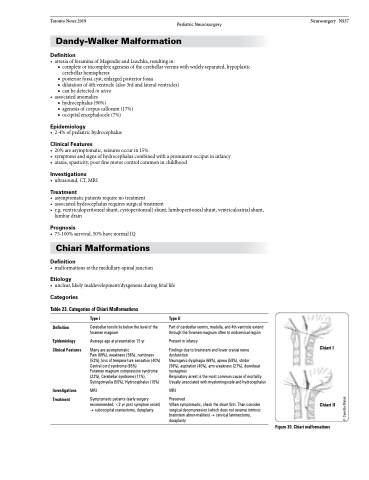Page 835 - TNFlipTest
P. 835
Toronto Notes 2019 Pediatric Neurosurgery Dandy-Walker Malformation
Definition
• atresiaofforaminaofMagendieandLuschka,resultingin:
■ complete or incomplete agenesis of the cerebellar vermis with widely separated, hypoplastic
cerebellar hemispheres
■ posterior fossa cyst, enlarged posterior fossa
■ dilatation of 4th ventricle (also 3rd and lateral ventricles) ■ can be detected in utero
• associatedanomalies
■ hydrocephalus (90%)
■ agenesis of corpus callosum (17%) ■ occipital encephalocele (7%)
Epidemiology
• 2-4%ofpediatrichydrocephalus
Clinical Features
• 20%areasymptomatic,seizuresoccurin15%
• symptomsandsignsofhydrocephaluscombinedwithaprominentocciputininfancy • ataxia,spasticity,poorfinemotorcontrolcommoninchildhood
Investigations
• ultrasound, CT, MRI
Treatment
• asymptomaticpatientsrequirenotreatment
• associatedhydrocephalusrequiressurgicaltreatment
• e.g.ventriculoperitonealshunt,cystoperitoneal)shunt,lumboperitonealshunt,ventriculoatrialshunt,
lumbar drain
Prognosis
• 75-100%survival,50%havenormalIQ
Chiari Malformations
Definition
• malformationsatthemedullary-spinaljunction
Etiology
• unclear,likelymaldevelopment/dysgenesisduringfetallife
Neurosurgery NS37
Categories
Table 23. Categories of Chiari Malformations
Definition
Epidemiology Clinical Features
Investigations Treatment
Type I
Cerebellar tonsils lie below the level of the foramen magnum
Average age at presentation 15 yr
Many are aysmptomatic
Pain (69%), weakness (56%), numbness (52%), loss of tempera-ture sensation (40%) Central cord syndrome (65%)
Foramen magnum compression syndrome (22%), Cerebellar syndrome (11%), Syringomyelia (50%), Hydrocephalus (10%)
MRI
Symptomatic patients (early surgery recommended; <2 yr post symptom onset) → suboccipital craniectomy, duraplasty
Type II
Part of cerebellar vermis, medulla, and 4th ventricle extend through the foramen magnum often to midcervical region
Present in infancy
Findings due to brainstem and lower cranial nerve dysfunction
Neurogenic dysphagia (69%), apnea (58%), stridor (56%), aspiration (40%), arm weakness (27%), downbeat nystagmus
Respiratory arrest is the most common cause of mortality Usually associated with myelomingocele and hydrocephalus
MRI
Preserved
When symptomatic, check the shunt first. Then consider surgical decompression (which does not reverse intrinsic brainstem abnor-malities) → cervical laminectomy, duraplasty
Chiari I
Chiari II Figure 30. Chiari malformations
© Camillia Matuk


